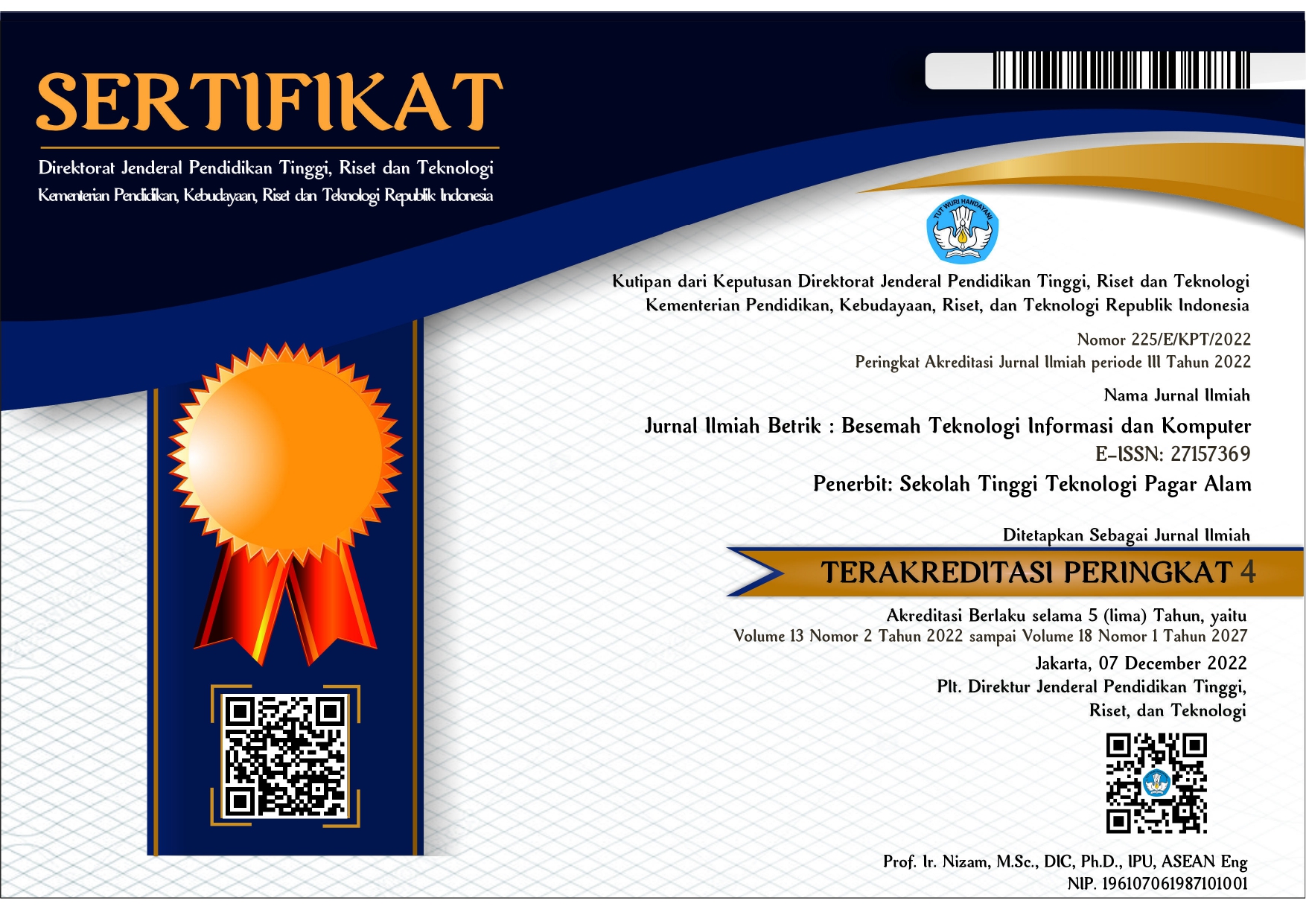KLASIFIKASI MAMALIA MENGGUNAKAN EXTREME GRADIENT BOOSTING BERDASARKAN FITUR HISTOGRAM OF ORIENTED GRADIENT
DOI:
https://doi.org/10.36050/betrik.v13i03%20DESEMBER.44Abstract
Mammals are one type of animal that has many characteristics and characteristics. The shape of the face in each type of mammal has a similar shape. The faces of mammals in the form of frontal images are a challenge in image classification. In this study, the Histogram of Oriented Gradient (HOG) is used as a feature of the facial shape of mammals. HOG is used as a strengthening feature in the classification process using the eXtreme Gradient Boosting (XGBoost) method. The test was carried out using a dataset of frontal facial imagery of mammals consisting of 15 species. The results of the tests show that the XGBoost method with the HOG feature is able to provide better classification results for mammals than without the HOG feature. This is indicated by an increase in the precision value of 0.61; recall of 0.62; and an f1-score of 0.60 on XGBoost with HOG feature which is almost double that of XGBoost without HOG feature.
References
M. N. Alli and S. Viriri, “Animal identification based on footprint recognition,” IEEE Int. Conf. Adapt. Sci. Technol. ICAST, 2013, doi: 10.1109/ICASTech.2013.6707488.
S. Taheri and Ö. Toygar, “Animal classification using facial images with score-level fusion,” IET Comput. Vis., vol. 12, no. 5, pp. 679–685, 2018, doi: 10.1049/iet-cvi.2017.0079.
M. E. Al Rivan and Y. Yohannes, “Klasifikasi Mamalia Berdasarkan Bentuk Wajah Dengan K-NN Menggunakan Fitur CAS Dan HOG,” J. Tek. Inform. dan Sist. Inf., vol. 5, no. 2, pp. 173–180, 2019.
Y. Yohannes, Y. P. Sari, and I. Feristyani, “Klasifikasi Wajah Hewan Mamalia Tampak Depan Menggunakan k-Nearest Neighbor Dengan Ekstraksi Fitur HOG,” J. Tek. Inform. dan Sist. Inf., vol. 5, no. 1, pp. 84–97, 2019, doi: 10.28932/jutisi.v5i1.1584.
Z. Cao, J. C. Principe, B. Ouyang, F. Dalgleish, and A. Vuorenkoski, “Marine Animal Classification Using Combined CNN and Hand-designed Image Features,” Ocean. 2015 - MTS/IEEE Washingt., pp. 2–7, 2015.
F. Fandiansyah, J. Y. Sari, and I. P. Ningrum, “Pengenalan Wajah Menggunakan Metode Linear Discriminant Analysis Dan K Nearest Neighbor,” J. Inform., vol. 11, no. 2, pp. 48–59, 2017, doi: 10.26555/jifo.v11i2.a5998.
G. Kunapuli, Ensemble Methods for Machine Learning Version 6. The MathWorks, Inc., 2022.
T. C. Nokeri, Data Science Solutions with Python. 2022. [Online]. Available: https://link.springer.com/10.1007/978-1-4842-7762-1
G. Kyriakides and K. G. Margaritis, Hands-On Ensemble Learning with Python. 2019.
Y. F. Munawaroh and I. Salamah, “Analisa Perbandingan Algoritma Histogram of Oriented Gradient (HOG) dan Gaussian Mixture Model (GMM) Dalam Mendeteksi Manusia,” Semin. Nas. Inov. dan Apl. Teknol. Di Ind. 2018, vol. 4, no. 2, pp. 251–255, 2018.
G. Ning, “Vehicle License Plate Detection and Recognition,” University of Missouri, Columbia, 2013.
Y. Yohannes, M. R. Pribadi, and L. Chandra, “Klasifikasi Jenis Buah dan Sayuran Menggunakan SVM Dengan Fitur Saliency-HOG dan Color Moments,” Elkha, vol. 12, no. 2, p. 125, 2020, doi: 10.26418/elkha.v12i2.42160.
Y. Yohannes and M. E. Al Rivan, “Penggunaan Global Contrast Saliency dan Histogram of Oriented Gradient Sebagai Fitur untuk Klasifikasi Jenis Hewan Mamalia,” Petir, vol. 13, no. 1, pp. 80–85, 2020, doi: 10.33322/petir.v13i1.908.
Y. Jiang, G. Tong, H. Yin, and N. Xiong, “A Pedestrian Detection Method Based on Genetic Algorithm for Optimize XGBoost Training Parameters,” IEEE Access, vol. 7, pp. 118310–118321, 2019, doi: 10.1109/ACCESS.2019.2936454.
Z. Si and S. Zhu, “Learning Hybrid Image Templates (HIT) by Information Projection,” IEEE Trans. Pattern Anal. Mach. Intell., pp. 1354–1367, 2012.
N. Dalal and B. Triggs, “Histograms of Oriented Gradients for Human Detection,” in 2005 IEEE Computer Society Conference on Computer Vision and Pattern Recognition (CVPR’05), 2005, vol. 1, pp. 886–893. doi: 10.1109/CVPR.2005.177.
L. Wang, D. Zhou, H. Zhang, W. Zhang, and J. Chen, “Application of Relative Entropy and Gradient Boosting Decision Tree to Fault Prognosis in Electronic Circuits,” Symmetry (Basel)., vol. 10, no. 10, 2018, doi: 10.3390/sym10100495.
Y. Chen, X. Wang, Y. Jung, V. Abedi, R. Zand, M. Bikak, and M. Adibuzzaman, “Classification of short single-lead electrocardiograms (ECGs) for atrial fibrillation detection using piecewise linear spline and XGBoost,” Physiol. Meas., vol. 39, no. 10, 2018, doi: 10.1088/1361-6579/aadf0f.
T. Chen and C. Guestrin, “XGBoost : A Scalable Tree Boosting System,” Proc. 22nd ACM SIGKDD Int. Conf. Knowl. Discov. Data Min., pp. 785–794, 2016, doi: 10.1145/2939672.2939785.
R. Guo, Z. Zhao, T. Wang, G. Liu, J. Zhao, and D. Gao, “Degradation State Recognition of Piston Pump Based on ICEEMDAN and XGBoost,” Appl. Sci., vol. 10, no. 18, pp. 1–17, 2020, doi: 10.3390/app10186593.
Downloads
Published
How to Cite
Issue
Section
License
Copyright (c) 2023 Yohannes, Johannes Petrus

This work is licensed under a Creative Commons Attribution 4.0 International License.
















